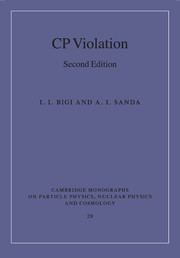Preface to the first edition
Published online by Cambridge University Press: 10 March 2010
Summary
Some discoveries in the sciences profoundly change how we view nature. The discovery of parity violation in the weak interactions in 1956 certainly falls into this illustrious category. Yet it just started the shift to a new perspective; it was the discovery of CP violation in 1964 by Christenson, Cronin, Fitch and Turlay at Brookhaven National Lab – completely unexpected to almost all despite the experience of 8 years earlier – that established the new paradigm that even in the microscopic regime symmetries should not be assumed to hold a priori, but have to be subjected to determined experimental scrutiny.
It would seem that after the initial period of discoveries little progress has been achieved, since despite dedicated efforts CP violation has not been observed outside the decays of KL mesons, nor can we claim to have come to a real understanding of this fundamental phenomenon.
We have, however, ample reason to expect imminent dramatic changes. Firstly, direct CP violation has been observed in KL decays. Secondly, our phenomenological and theoretical descriptions have been refined to the point that we can predict with confidence that the known forces of nature will generate huge CP asymmetries, which could even be close to 100%, in the decays of so-called beauty mesons. Dedicated experiments are being set up to start taking data that would reveal such effects before the turn of the millennium. What they observe – or do not observe – will shape our knowledge of nature's fundamental forces.
We consider it thus an opportune time to take stock, to represent CP invariance and its limitations in its full multi-layered complexity.
- Type
- Chapter
- Information
- CP Violation , pp. xix - xxPublisher: Cambridge University PressPrint publication year: 2009



